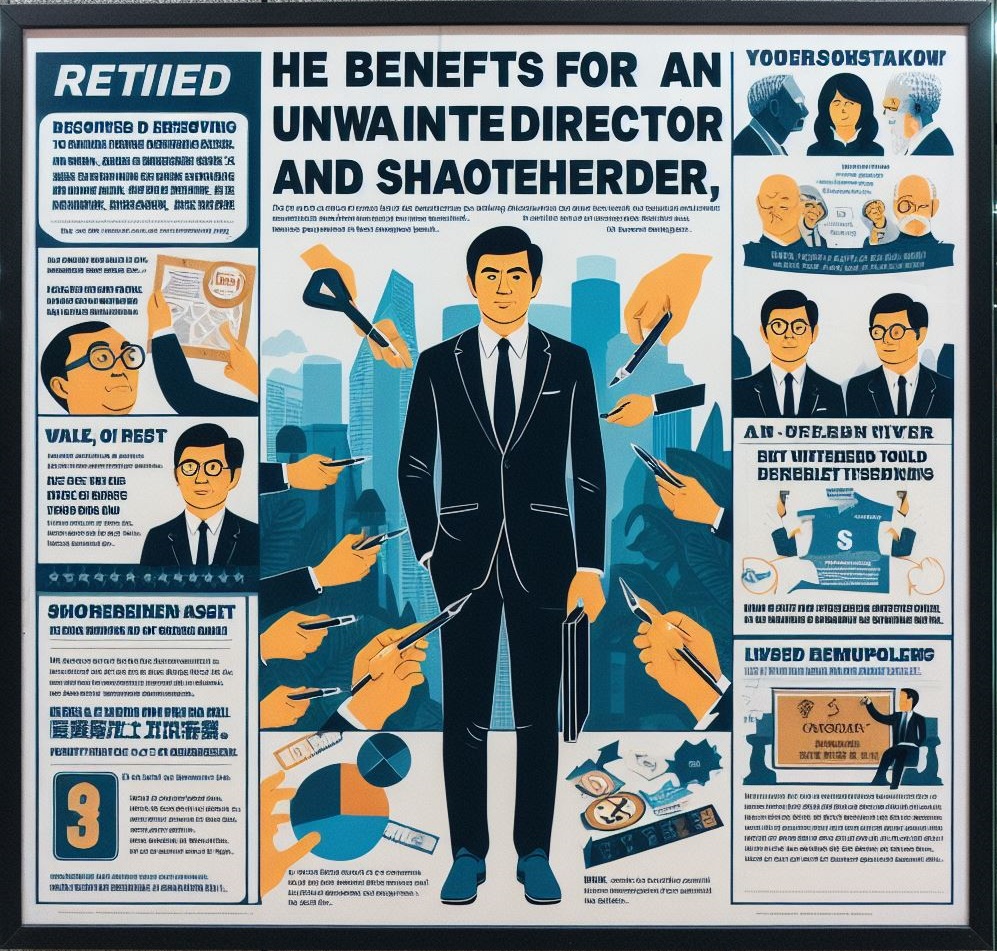Introduction
The process of removing an unwanted director and shareholder involves several key steps within the realms of corporate governance and legal compliance. Initiating with a board resolution, the procedure necessitates convening a shareholder meeting, passing special resolutions, and adhering to notice periods as stipulated by company law and articles of association. Legal grounds for removal, such as breaches of fiduciary duty, play a crucial role, and communication strategies are pivotal in notifying affected parties. Filing requirements with regulatory authorities, compliance with corporate laws, and ethical considerations add further complexity. Research keywords encompass corporate governance, legal frameworks, articles of association, special resolutions, and regulatory compliance, facilitating a comprehensive exploration of this multifaceted process.
In a company, sometimes unusual circumstances pop up which requires removing unwanted directors and shareholders for the smooth operation of it. This article will lay out the procedures and possible avenues for the removal of unwanted directors and shareholders.
Contents
- 1
- 2 Procedure for Removing an Unwanted Director and Shareholder
- 3 Contact Us Easily
- 4
- 5 What is extraordinary resolution?
- 6 Requirements to be fulfilled for removal of the director
- 7 Can individual shareholders call for a meeting for the removal of the director?
- 8 Potential options available in removing a shareholder
- 9 Conclusion
What Can Learn From the Article?
- Corporate governance and legal compliance drive the removal process.
- Steps involve board resolution, shareholder meetings, special resolutions, and notice periods.
- Legal grounds focus on breaches of fiduciary duty.
- Effective communication is vital for notifying affected parties.
- Filing complexities include regulatory requirements, corporate laws, and ethical considerations.
- Corporate governance, legal frameworks, articles of association, special resolutions, and regulatory compliance.
- Bangladesh’s procedure under the Companies Act involves resolutions and court orders.
- Extraordinary resolutions require notice and a three-fourths majority vote.
- Director removal requires an opportunity for representation and shareholder review.
- Options for removing shareholders include articles of association, voluntary liquidation, and legal actions under Section 233.

Procedure of Removing an Unwanted Director and Shareholder
Procedure of Removing an Unwanted Director and Shareholder. Under the Companies Act of Bangladesh, a director of a company can be removed
(a) by passing a resolution, and
(b) by the order of the court.
Section 106 of the Companies Act 1994 empowers the company to remove a director by extraordinary resolution before the expiry of his period of office. In this respect, Section, 106(1) states that the company may by extraordinary resolution remove any share-holder director before the expiration of his period of office and may by, ordinary resolution appoint another person in his stead: and the person so appointed shall be subject to retirement at the same time as if lie laid become a director on the day on which the director in whose place he is appointed was last elected director, To remove any director or to appoint somebody in his place at the meeting at which he is removed by an extraordinary resolution, a Special notice is required to be On receipt of such notice, the company will immediately send a copy thereof to the director concerned, he shall be entitled to be heard before passing the resolution on the meeting for Procedure of Removing an Unwanted Director and Shareholder.
Contact Us Easily
What is extraordinary resolution?
According to section 87 (1) of the Companies Act, a resolution is an extraordinary resolution if
(i) In the notice it was mentioned that this would be an extraordinary resolution;
ii) passed by a majority of three-fourths of the members who are entitled to vote as are present in person or by proxy, where the proxy is allowed.
Requirements to be fulfilled for removal of the director
1. The director concerned must be given a reasonable opportunity to make representations against the proposal for his removal.
2. The shareholders of the company should be given adequate opportunity to get acquainted with such representations before they subscribe to a resolution for removal.
An individual shareholder has no right by himself and alone, to convene a meeting of the company for considering a resolution of a director.

Automatic vacation of office of the Director
If a director becomes disqualified by law or by the articles from continuing to be director, he automatically vacates office.
Section 108 mentions the circumstances when the director will be considered disqualified, some of the points are mentioned following
a. He is found to be of unsound mind by a competent court
b. If he is adjudged insolvent
c. If he absences himself from three consecutive meetings of the directors or all the meetings of the directors for a continuous period of three months, whichever is longer, without leave of absence from the Board of Directors.
There is no automatic right for majority shareholders to force a minority shareholder to sell his/her shares. Some of the following options can be explored to remove an unwanted minority shareholder:
Using the article of association
it is a good idea to refer back to the company’s articles of association for any provisions which would enable the majority shareholders to force the minority shareholders to sell. Well-drafted articles of association can be a valuable asset when removing a difficult minority shareholder and using the shareholder agreement where there is a shareholder agreement that contains clauses providing for the company to buy back the minority shareholder’s shares.
Voluntary liquidation
This is an aggressive approach. The majority shareholder who is holding a 75% share can consider winding it up under a member’s voluntary liquidation. It transfers all the assets of the company to a new company with the purpose that the minority shareholder receives no share in the new company.
Concept of prejudice
A Petitioner may bring an action claiming the conduct of a minority shareholder is unfairly prejudiced against him. An offer to buy out made by the majority shareholder will also be considered as a possible remedy under this heading. Hoffman J. in Re a Company remarked that where there was an irretrievable breakdown of relations between members of a corporate quasi-partnership, the exclusion of a member from management and employment was not ipso facto unfairly prejudicial conduct. He went on to say that …if there is to be a parting, it is reasonable that he (the minority shareholder) should leave rather than the other members and on the terms, he is offered for his shares.
Under which section prejudice can be invoked?
Under section 233 the unfair prejudice petition can be invoked. Although the caption of the section says it is exclusively for the minority shareholders, The Calcutta High Court in Rama Shankar Prasad vs. Sandri Iron Foundry (P) Ltd held that the majority can apply for relief under this section (Rama Shankar Prasad vs. Sindhri Iron Foundry (P) Ltd., 1966). In Jadavlal Dutt vs. Hooghly Ink Company Ltd. and several other cases, it was held that:
– The right to apply is not confined to an oppressed minority of the shareholders alone. An oppressed majority also may apply (Jadavlal Dutt vs. Hooghly Ink Company Ltd., 1982). In Maharastra Power Development Corpn. Ltd vs. Dabhol Power Co. Ltd. the court took the view that: ―Where this requirement is satisfied, it would be immaterial whether the oppression is being spelled out to a majority block by a minority block or by a one minority group to another minority group (Maharastra Power Development Corpn. Ltd. vs Dabhol Power Co. Ltd., 2003). A petition is not liable to be struck out as showing no reasonable cause of action only because the petitioner happens to be a majority shareholder (Re Baltic Real Estate Ltd., 1993). Oppression is the fundamental requirement to proceed under this section. To have the privilege of protection, the shareholders have to satisfy two components; Firstly, oppression by a part of the shareholders against the others; and Secondly, the threshold provided by section 195. Nowhere in the section, it is stated that only minority shareholders having less than 50% stake in the company can proceed under this section.
Despite the caption of section 233 stating that the Power of the court to give direction for protecting the interest of the minority the caption is not to be deemed as law. It seems that satisfying the minimum 10% threshold any part of the shareholders can proceed against others subject to the fact that the oppression or prejudicial action or omission has been done to the other part of the shareholder.
Conclusion
Each case needs to be carefully considered on its merits. Most shareholders’ disputes are resolved by having the majority buy out the minority shares for fair value. A corporate law specialist has to evaluate the issues on a case-by-case basis. Counsels Law Partners CLP provides all kinds of legal services about Company and corporate matters. Counsels Law Partners is one of the leading Law chambers in Gulshan, Dhaka, Bangladesh. If you require any legal help about the company and corporate matters, please reach us at:
- Phone: +8801700920980
- Could you email us: info@counselslaw.com?
- Address: House No. 4/A/1, Road No. 02, Gulshan-1, Dhaka-1212, Bangladesh.

